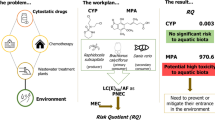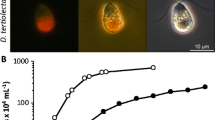Abstract
The residues of antineoplastic drugs are considered as new and emerging pollutants in aquatic environments. Recent experiments showed relatively high toxicity of 5-fluorouracil (5-FU), imatinib mesylate (IM), etoposide (ET) and cisplatin (CP) that are currently among most widely used antineoplastic drugs, against phytoplankton species. In this study, we investigated the toxic potential of the mixture of 5-FU + IM + ET against green alga Pseudokirchneriella subcapitata and cyanobacterium Synechococcus leopoliensis, and the stability and sorption of these drugs to algal cells. Toxic potential of the mixture was predicted by the concepts of ‘concentration addition’ and ‘independent action’ and compared to the experimentally determined toxicity. In both test species, the measured toxicity of the mixture was at effects concentrations EC10–EC50 higher than the predicted, whereas at higher effect concentration (EC90), it was lower. In general, P. subcapitata was more sensitive than S. leopoliensis. The stability studies of the tested drugs during the experiment showed that 5-FU, IM and CP are relatively stable, whereas in the cultures exposed to ET, two transformation products with the same mass as ET but different retention time were detected. The measurements of the cell-linked concentrations of the tested compounds after 72 h exposure indicated that except for CP (1.9 % of the initial concentration), these drugs are not adsorbed or absorbed by algal cells. The results of this study showed that in alga and cyanobacteria exposure to the mixture of 5-FU + ET + IM, in particular at low effect concentration range, caused additive or synergistic effect on growth inhibition, and they suggest that single compound toxicity data are not sufficient for the proper toxicity prediction for aquatic primary producers.




Similar content being viewed by others
References
Altenburger R, Greco WR (2009) Extrapolation concepts for dealing with multiple contamination in environmental risk assessment. Integr Environ Assess Manag 5:62–68
Backhaus T, Karlsson M (2014) Screening level mixture risk assessment of pharmaceuticals in STP effluents. Water Res 49:157–165
Besse JP, Latour JF, Garric J (2012) Anticancer drugs in surface waters: what can we say about the occurrence and environmental significance of cytotoxic, cytostatic and endocrine therapy drugs? Environ Int 39:73–86
Bliss CI (1939) The toxicity of poisons applied jointly. Ann Appl Biol 26:585–615
Booker V, Halsall C, Llewellyn N, Johnson A, Williams R (2014) Prioritising anticancer drugs for environmental monitoring and risk assessment purposes. Sci Total Environ 473–474:159–170
Brain RA, Johnson DJ, Richards SM, Hanson ML, Sanderson H, Lam MW, Young C, Mabury SA, Sibley PK, Solomon KR (2004) Microcosm evaluation of the effects of an eight pharmaceutical mixture to the aquatic macrophytes Lemna gibba and Myriophyllum sibiricum. Aquat Toxicol 70(1):23–40
Brezovsek P, Elersek T, Filipic M (2014) Toxicities of four anti-neoplastic drugs and their binary mixtures tested on the green alga Pseudokirchneriella subcapitata and the cyanobacterium Synechococcus leopoliensis. Water Res 52:168–177
Chou TC, Martin N (2007) CompuSyn software for drug combinations and for general dose effect analysis, and user’s guide. ComboSyn, Inc. Paramus, NJ. http://www.combosyn.com. Accessed 15 May 2014
Chou TC, Talalay P (1984) Quantitative analysis of dose-effect relationship: the combined effects of multiple drugs or enzyme inhibitors. Adv Enzym Regul 22:27–55
Cleuvers M (2003) Aquatic ecotoxicity of pharmaceuticals including the assessment of combination effects. Toxicol Lett 142:185–194
Eitel A, Scherrer M, Kuemmerer K (2000) Handling cytostatic drugs: a practical guide. Bristol-Myers-Squibb, München
Elersek T (2012) The advantages of flow cytometry in comparison to fluorimetric measurement in algal toxicity test. Acta Biol Slov 55(2):3–11
Fabarius A, Giehl M, Frank O, Duesberg P, Hochhaus A, Hehlmann R, Seifarth W (2005) Induction of centrosome and chromosome aberrations by imatinib in vitro. Leukemia 19:1573–1578
Fabarius A, Giehl M, Frank O, Spiess B, Zheng C, Muller MC, Weiss C, Duesberg P, Hehlmann R, Hochhaus A, Seifarth W (2007) Centrosome aberrations after nilotinib and imatinib treatment in vitro are associated with mitotic spindle defects and genetic instability. Br J Haematol 138:369–73
Faust M, Altenburger R, Backhaus T, Bodeker W, Scholze M, Grimme LH (2000) Predictive assessment of the aquatic toxicity of multiple chemical mixtures. J Environ Qual 29:1063–1068
Fava C, Rege-Cambrin G, Saglio G (2015) The choice of first-line chronic myelogenous leukemia treatment. Ann Hematol 94(2):S123–31
Fent K, Weston AA, Caminada D (2006) Ecotoxicology of human pharmaceuticals. Aquat Toxicol 76:122–159
Hagenbuch IM, Pinckney JL (2012) Toxic effect of the combined antibiotics ciprofloxacin, lincomycin, and tylosin on two species of marine diatoms. Water Res 46:5028–5036
Hernando MD, Mezcua M, Fernández-Alba AR, Barceló D (2006) Environmental risk assessment of pharmaceutical residues in wastewater effluents, surface waters and sediments. Talanta 69(2):334–342
Hughes SR, Kay P, Brown LE (2012) Global synthesis and critical evaluation of pharmaceutical data sets collected from river systems. Environ Sci Technol 47(2):661–677
Jia J, Zhu F, Ma X, Cao ZW, Li YX, Chen YZ (2009) Mechanisms of drug combinations: interaction and network perspectives. Nat Rev Drug Discov 8:111–128
Kosjek T, Heath E (2011) Occurrence, fate and determination of cytostatic pharmaceuticals in the environment. Trends Anal Chem 30(7):1065–1087
Kosjek T, Perko S, Žigon D, Heath E (2013) Fluorouracil in the environment: analysis, occurrence, degradation and transformation. J Chromatogr A 1290:62–72
Kuemmerer K, Al-Ahmad A, Bertram B, Wießler M (2000) Biodegradability of antineoplastic compounds in screening tests: influence of glucosidation and of stereochemistry. Chemosphere 40(7):767–773
Lenz K, Mahnik SN, Weissenbacher N, Mader RM, Krenn P, Hann S, Koellensperger G, Uhl M, Knasmueller S, Ferk F, Bursch W, Fuerhacker M (2007) Monitoring, removal and risk assessment of cytostatic drugs in hospital wastewater. Water Sci Technol 56(12):141–149
Loewe S, Muischnek H (1926) Ueber kombinationswirkungen. 1. Mitteilung: Hilfsmittel der fragestellung. Schmiedeb. Arch Exp Pathol Pharmakol 114:313–326
Magnusson M, Heimann K, Quayle P, Negri AP (2010) Additive toxicity of herbicide mixtures and comparative sensitivity of tropical benthic microalgae. Mar Pollut Bull 60(11):1978–1987
Mahnik SN, Rizovski B, Fuerhacker M, Mader RM (2004) Determination of 5-fluorouracil in hospital effluents. Anal Bioanal Chem 380:31–35
Martín J, Camacho-Muñoz D, Santos JL, Aparicio I, Alonso E (2014) Occurrence and ecotoxicological risk assessment of 14 cytostatic drugs in wastewater. Water Air Soil Pollut 225:10
Misik M, Pichler C, Rainer B, Filipic M, Nersesyan A, Knasmueller S (2014) Acute toxic and genotoxic activities of widely used cytostatic drugs in higher plants: possible impact on the environment. Environ Res 135:196–203
Negreira N, Mastroianni N, Lopez de Alda M, Barcelo D (2013) Multianalyte determination of 24 cytostatics and metabolites by liquid chromatography-electrospray-tandem mass spectrometry and study of their stability and optimum storage conditions in aqueous solution. Talanta 116:290–299
Negreira N, Lopez de Alda M, Barcelo D (2014a) Study of the stability of 26 cytostatic drugs and metabolites in wastewater under different conditions. Sci Total Environ 482(3):389–398
Negreira N, Lopez de Alda M, Barceló D (2014b) Cytostatic drugs and metabolites in municipal and hospital wastewaters in Spain: filtration, occurrence, and environmental risk. Sci Total Environ 497–498:68–77
OECD TG 201 (2011) Organisation for Economic Co-operation and Development (OECD) Guidelines for the Testing of Chemicals, Section 2: Effects on Biotic Systems Test No. 201: Freshwater Alga and Cyanobacteria, Growth Inhibition Test OECD. OECD Publishing
Parrella A, Lavorgna M, Criscuolo E, Russo C, Fiumano V, Isidori M (2014) Acute and chronic toxicity of six anticancer drugs on rotifers and crustaceans. Chemosphere 115:59–66
Pfleeger T, McFarlane JC, Sherman R, Volk G (1991) A short-term bioassay for whole plant toxicity. In: Gorsuch JW et al. (ed) Plant for toxicity assessment Vol 2 ASTM publ. 04-011150-16. American society of testing and materials, West Conshohocken, 355–364
Pomati F, Orlandi C, Clerici M, Luciani F, Zuccato E (2008) Effects and interactions in an environmentally relevant mixture of pharmaceuticals. Toxicol Sci 102(1):129–137
Rodriguez-Mozaz S, Howard SW (2010) Meeting report: pharmaceuticals in water—an interdisciplinary approach to a public health challenge. Environ Health Perspect 118(7):1016–1020
Silva E, Rajapakse N, Kortenkamp A (2002) Something from “nothing” - eight weak estrogenic chemicals combined at concentrations below NOECs produce significant mixture effects. Environ Sci Technol 36:1751–1756
Simpson SL, Roland MGE, Stauber JL, Batley GE (2003) Effect of declining toxicant concentrations on algal bioassay endpoints. Environ Toxicol Chem 22:2073–2079
Sumpter JP, Johnson AC, Williams RJ, Kortenkamp A, Scholze M (2006) Modeling effects of mixtures of endocrine disrupting chemicals at the river catchment scale. Environ Sci Technol 40(17):5478–5489
Xie H (2012) Occurrence, ecotoxicology, and treatment of anticancer agents as water contaminants. J Environ Anal Toxicol S2:1–11
Acknowledgments
This study received funding from the Seventh Framework Programme FP7/2007-2013 under grant agreement No 265264 (CytoThreat). The authors would like to thank to Mihael Bricelj, Katja Kološa, Karmen Stanič and Kazimir Drašlar for their assistance at the experimental work.
Author information
Authors and Affiliations
Corresponding author
Additional information
Responsible editor: Philippe Garrigues
Rights and permissions
About this article
Cite this article
Elersek, T., Milavec, S., Korošec, M. et al. Toxicity of the mixture of selected antineoplastic drugs against aquatic primary producers. Environ Sci Pollut Res 23, 14780–14790 (2016). https://doi.org/10.1007/s11356-015-6005-2
Received:
Accepted:
Published:
Issue Date:
DOI: https://doi.org/10.1007/s11356-015-6005-2




